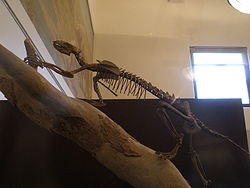- Miacoidea
-
Miacoids Scientific classification Kingdom: Animalia Phylum: Chordata Class: Mammalia (unranked): Carnivoramorpha Superfamily: Miacoidea
Cope, 1880Families - Miacidae (type)
- Viverravidae
Miacoidea is paraphyletic superfamily that had been traditionally divided into two families of carnivores: Miacidae (the miacids) and Viverravidae. Miacoids were primitive carnivores which lived during the Paleocene and Eocene Epoch about 33-65 million years ago. Today, Miacidae is recognized as a paraphyletic array of stem taxa that probably resulted in some "miacid" genera ending up just outside the order Carnivora, the crown-group within the Carnivoramorpha. Carnivoramorpha consists of both Miacoidea and Carnivora, but excludes the order Creodonta that existed alongside Carnivoramorpha. Miacoids are regarded as basal carnivoramorphs. The miacids are a paraphyletic group containing all miacoids that are not viverravids.
The transition from miacids to Carnivora was a gradual trend during the Paleocene to late Eocene, with taxa from both North America and Eurasia involved. The miacids did not appear until the very end of the Paleocene and are characterized by their shorter skull, and loss of contact between the calcaneum and fibula in the ankle.
Viverravidae are an earlier, Paleocene, group. In the Viverravidae the number of molars is reduced to two and the skull is elongated. The Viverravidae are a monophyletic family, a plesion-group. Viverravidae are not considered related to any extant carnivores[1].
Miacoids were mostly small carnivores superficially reminiscent of martens or civets. They probably fed on invertebrates, lizards, birds and smaller mammals like shrews and opossums, while others may have been insectivores. Some species were arboreal, others lived on the ground. Their teeth and skull show that the miacoids were less developed than modern carnivores.
Classification
- Clade Carnivoramorpha
- Superfamily †Miacoidea
- Family †Miacidae
- genera: Eosictis, Ictognathus, Miacis, Miocyon, Oodectes, Palaearctonyx, Paramiacis, Paroodectes, Prodaphaenus, Quercygale, Tapocyon, Uintacyon, Vassacyon, Vulpavus, Xinyuictis, Ziphacodon
- Family †Viverravidae
- genera: Bryanictis, Didymictis, Ictidopappus, Mustelodon, Pristinictis, Protictis, Raphictis, Simpsonictis, Viverravus
- Family †Miacidae
- Superfamily †Miacoidea
References
- ^ Wesley-Hunt, G.D.; Flynn J.J. (2005). Phylogeny of the Carnivora: Basal Relationships Among the Carnivoramorphans, and Assessment of the Position of 'Miacoidea' Relative to Carnivora. Journal of Systematic Paleontology, 3: 1-28. DOI:10.1017/S1477201904001518
Categories:- Carnivorans
- Prehistoric carnivorans
Wikimedia Foundation. 2010.


